The Story of Hollywood and the Second World War
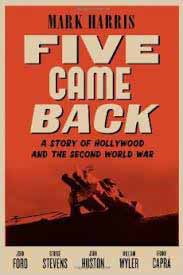 Mark Harris’ book Five Came Back: A Story of Hollywood and the Second World Warrecently came out in paperback — just in time for the 70th anniversary of VE-Day (May 8, 1945) and a few months shy of VJ-Day (Sept. 2, 1945).
Mark Harris’ book Five Came Back: A Story of Hollywood and the Second World Warrecently came out in paperback — just in time for the 70th anniversary of VE-Day (May 8, 1945) and a few months shy of VJ-Day (Sept. 2, 1945).
Harris describes his book as “a work of history and of collective biography.” The history component is developed in time-increment chapters that begin in Hollywood in March 1938 and end in that U.S. film capital eight years later. Harris uses the period to look at the progressive treatment of World War II as experienced by five top directors who enlisted in the U.S. military and made information, training, and documentary films that would shape public opinion about the war.
The “collective biography” component comes in as the book follows the wartime careers of John Huston, William Wyler, John Ford, Frank Capra, and George Stevens. Using the directors’ memoirs and hundreds of historical sources, Harris constructs a remarkable and fascinating story about how these iconic filmmakers helped recruit and orient servicemen, tell them “the whys and wherefores of this war,” create propaganda that would counter Ad0lf Hitler’s, and build morale by depicting the American servicemen in combat on land, at sea, and in the air.
Deployed
Hollywood in the late 1930s was a place struggling to find its voice in response to the shocking stream of news and events coming out of war-torn Europe. Occasionally, films such as Confessions of a Nazi Spy (1939), The Mortal Storm (1940), and The Long Voyage Home (1940) delivered war-related material to audiences — but not with any degree of political boldness. Even so, anti-interventionists in Washington accused the industry of making message-oriented films at the behest of President Franklin D. Roosevelt.
One politician in particular, Republican Sen. Gerald P. Nye of North Dakota, attacked Hollywood for being an industry run by “foreigners,” made up mostly of people with “non-Nordic” last names. In a harshly invective speech in 1941 Nye referred to the Hollywood studios as “the most potent and dangerous ‘fifth column’ in our country.”
The film that most provoked Nye and other isolationists was Howard Hawks’ Sergeant York (1941), made at Warner Bros. During the 1930s Warner Bros. had developed a reputation as Hollywood’s most “message”-prone studio, and Sergeant York was seen as being perfectly themed for a pro-intervention screen drama. The plot was inspired by the real-life story of World War I hero Alvin C. York, a folksy Tennessean whose army outfit had killed more than 20 German soldiers and captured dozens of others.
Huston wrote the screenplay (heavily doctored in the treatment of its protagonist’s heroics) and Gary Cooper, an actor known for his on-screen naturalism, portrayed York. When the film premiered on July 2, 1941, one reviewer described it as Hollywood’s “first solid contribution to national defense.” Daily Variety deemed it “as timely a release as a White House fireside chat.”
For Nye and a four-man congressional committee Sergeant York provided good reason to initiate hearings focused on Hollywood’s interventionist “tendencies.” Wendell Wilkie, defeated by Roosevelt in the 1940 presidential election, was hired by the Motion Picture Producers and Distributors of America to be its spokesman at the hearings. Wilkie, an avowed pro-interventionist — one of the rare Republican figures to admit it — spoke eloquently against the infuriated Nye and his cohorts’ charges against Hollywood. Nye remained defiant until the Dec. 7, 1941, attack on Pearl Harbor ended the committee’s campaign.
Opening credits
This is where Five Came Back picks up the story of Hollywood’s role in World War II. John Ford, at age 46, would be the first of the five directors to enlist in the military. He joined the navy three months before Pearl Harbor. Next went William Wyler, age 34, followed by John Huston, age 35, Frank Capra, age 44, and George Stevens, age 37. Each signed up for service in the Signal Corps.
The directors would face numerous battles of their own as the war progressed — political, ideological, logistical, and personal. Harris covers them all in his book. The author is most impressive when bringing the important films to life, capturing and conveying each director’s cinematic methods amid challenging locations and circumstances. In just one four-year period, Ford, Wyler, Huston, Capra, and Stevens made hundreds of short and long films in both the fiction and nonfiction genres.
Representative examples from each of the directors point to the varied techniques and styling that distinguished their war pictures.
John Huston
Huston was sent in 1942 by the Signal Corps to Adak, one of the larger of the Aleutian islands in the Bering Sea, to film a U.S. initiative to take back the islands of Kiska and Attu, which had been seized by the Japanese army.
Arriving on Adak, Huston and his five-man film crew discovered a sparse, stark, chilly landscape with makeshift accommodations along the beachfront. No plans for an aerial mission to reclaim the two islands seemed imminent; the first time Huston had ridden on a flying mission, it was aborted. He began to rethink the kind of film he might make, especially after his expected 45-day stay on Adak turned into four months.
When completed in 1943, Huston’s Report from the Aleutians was a unique military film that in its first half presented war as “the despoliation of nature,” shown in a travelogue-styled coverage of the “fogbound-forbidding landscape,” with the camera panning and tracking across the barren horizon. Huston’s own narration casts the location as “next to worthless in human existence.”
The second half of the documentary shows the energetic preparations of a military initiative that never occurs during Huston’s stay. The singular nature of Report from the Aleutians generated controversy, but Harris aptly describes its depiction of the World War II front “as unlike any that had been featured in gung-ho newsreels … a melancholy, almost poetic portrayal of waiting and watchfulness, of the lonely languor of the American fighting man who has no one to fight.”
William Wyler
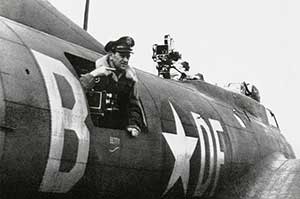
William Wyler on board the B-17 “Bad Penny” of the 8th Air Force’s 91st Bomb Group. He filmed part of “The Memphis Belle” from this vantage point and perspective.(Flickr; scanned from “Stars at War” by Michael Munn.)
Wyler, who in late 1941 had made the hugely popular Mrs. Miniver about a British family enduring German air raids, would direct The Memphis Belle: The Story of a Flying Fortress in 1944. This masterpiece showcased the 91st Bomb Group’s B-17 aerial combat missions from England into enemy territory. Wyler’s goal was to convey “the combination of adrenaline, terror, and exhilaration … along with the intense bonding of the Belle’s crews.”
Wyler chose to use only actual footage filmed during the missions, no re-enactments. In his literal, realistic conveyance of an air battle front, Wyler employed “an evocative, detailed, minute-by-minute style of second-person narration” as shots from the B-17 displayed the passing landscape below. The narration drops out as the bombing begins, again starkly realistic and intense. The 41-minute documentary concluded with the ground crew nervously counting the planes as they returned from their mission. When Memphis Belle opened in 1944 it became the first film ever to be reviewed on the front page of The New York Times. Wyler’s film had succeeded in jolting “moviegoers out of the apathy that overexposure to the war had bred.”
John Ford
Ford’s The Battle of Midway (1942) was a case study of U.S. military efforts to maintain control of the small cluster of islands in the North Pacific. Ford and his Field Photo cameramen were sent to Midway, an atoll island, on June 2, 1942, to cover an inevitable Japanese attack and ensuing battle. When the attack began Ford’s crew captured the action in an immediate verite camera style from the roof of the island’s main power station. They experienced near-deadly consequences as Japanese bombs fell. Three days later the battle was over and the U.S. was victorious.
The U.S. Navy had lost planes and men, but Japanese casualties numbered in the thousands. Four of the six Japanese aircraft carriers were destroyed. When completed, The Battle of Midway would play out in 18 minutes of Fordian drama, with a soundtrack that contained two narrators, and two unseen characters — a mother and her son who appear to be commenting on the battle scenes. Dudley Nichols (a 1918 U-M graduate and screenwriter on Ford’s Stagecoach, 1939) contributed to the script. Donald Crisp, Ford’s How Green Was My Valley (1941) co-star was one of the narrators, and Jane Darwell and Henry Fonda of Ford’s The Grapes of Wrath (1940) were cast as the voices of mother and son. As in those two earlier fiction films Ford turned The Battle of Midway into a story about “loss, duty, and sacrifice.”
The film premiered at the White House, after which 500 prints were made for nationwide distribution in September 1942. Ford said he wanted every mother in the country to see his film.
Frank Capra
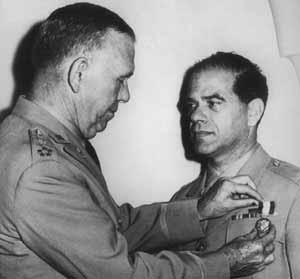
Frank Capra receives the Distinguished Service Medal from Chief of Staff Gen. George C. Marshall in 1945.
Capra was the most prolific of the five Hollywood directors-turned-military-documentarists. As director and supervisor his important works included the seven-part Why We Fight series, the Hey Soldier! information cartoons, and the Know Your Allies and Know Your Enemies documentaries, plus numerous military training shorts.
One less-known but highly heralded documentary was The Negro Soldier (1944), which Capra had tried to get made two years earlier. He selected the little-known Stuart Heisler to direct. Capra was determined to make a documentary about black solders’ contributions to the war and show “this is his war and not a ‘white man’s’ war.’”
The script, by black writer Carlton Moss, begins with “the most crisply spoken, uncaricatured black minister seen in an American film up to that point” delivering a sermon before a large congregation of black churchgoers. The sermon recalls the boxing match between Joe Louis and Max Schmeling, visualized onscreen in newsreel footage. The minister says, “These two men … are matched again, this time in a far bigger arena and for far greater stakes.”
The sermon continues with an historical account of blacks helping “safeguard the country’s liberty” from the 1600s forward, and highlighting great black Americans from Booker T. Washington to Jesse Owens. A montage follows a young black soldier from induction, to training, to active service. The film concludes with the attack on Pearl Harbor.
What impressed viewers, critics, and important black writers like Richard Wright and Langston Hughes was the proud, dignified, and “uncomedic” portrayal of black people. The Signal Corps decided The Negro Soldier, made initially for GIs, should be available for general audiences. Soon a hundred 35-mm Technicolor prints of the 45-minute film were distributed nationwide. While Capra had left the making of the film almost entirely to Heisler and scriptwriter Moss, he was pleased that his efforts, against considerable odds and army resistance, had been realized.
George Stevens
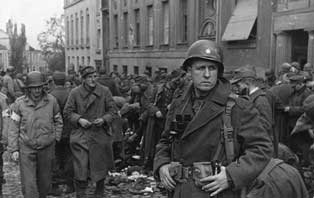
Prior to the war George Stevens was best known for directing light comedies. After the war he only directed dramas. (George Stevens papers, Margaret Herrick Library, Academy of Motion Picture Arts & Sciences.)
Before joining the Signal Corps Stevens was known best as a director of light Hollywood comedies, most notably the Laurel and Hardy shorts. The war would change that, with his most important work occurring in 1944-45 filming missions in Europe. The first began with D-Day and the last ended with coverage of the liberation of the Dora-Mittelbau and Dachau concentration camps in Germany.
Stevens was horrified by what he saw. As he and his 19-man unit began filming, he described it as “like wandering around in one of Dante’s infernal visions.” He shot footage of the piles of dead that he discovered were intermingled with the barely living. His goal was “to use his camera to make the unspeakable manifest.”
Eventually, Stevens began filming German men and women who were rounded up by the Allies and taken to the concentration sites for forced viewing of the wartime atrocities. Unrelenting close-ups remained focused on their faces as the Germans looked at, or refused to look at, what was before them. The idea was to reveal, not just to the world but to the German people themselves, what Hitler and his evil band had been capable of doing.
Stevens spent seven weeks of filming at Dachau and several months afterward completing two feature-length documentaries, Nazi Concentration and Prison Camps and The Nazi Plan, the latter about the decade of events and planning that preceded Hitler’s war crimes. The two films were screened as prosecutorial evidence at the Nuremberg trials, which began on Nov. 20, 1945 — the first film on Nov. 29, the latter two weeks later. Stevens’ films, says Harris, “had done what weeks of testimony had not. It made the defendants’ crimes irrefutable, and their fates inevitable.”
Stevens’ view of the world and the possibilities of filmmaking were changed forever. He never again directed comedy, selecting and directing only screen dramas.
Turn the page
An epistolary strand runs through Five Came Back in the recollection of the directors’ communication with and concern for the wives and children left behind. They had to make arrangements for family financial support since their incomes declined dramatically — from lucrative contracts with the film studios to meager checks distributed by the American military. How the wives coped with their husbands’ absences adds a personal element to the history, and the letters home provide introspective insights into the directors’ states of mind. In their letters, the wives send emotional support and report on life in Hollywood — tending to their children, the annual Oscar ceremonies, and volunteering at the Hollywood Canteen on Cahuenga Boulevard, a club for servicemen of all ranks.
Harris is a tireless purveyor of small but fascinating details that help expand the historical scope of his book. One facet is the cast of secondary characters who pop in and out of the narrative. Charles Lindbergh appears early on as a rabid isolationist and anti-Roosevelt campaigner. Theodore Geisel (later Dr. Seuss) comes into the story in 1942, having been recruited by Frank Capra as an animator for his humorous Hey Soldier! cartoon training films. Geisel, commissioned as a captain, shows up again in 1944 with a script about Germany for Capra’s Know Your Enemy documentary series, and later in 1945 as a narration writer for Your Job in Germany, an anticipatory training film for U.S. servicemen who would be “charged with keeping the peace” after Germany’s imminent defeat.
A huge cast of characters
Late in 1944 Humphrey Bogart and his wife at the time, Mayo Methot, were in Italy on a good-will tour. Harris describes how Huston discovers them one evening drinking in a makeshift Naples military bar. The director was in the country making his iconic war picture The Battle of San Pietro. That same year, as the Allies were marching toward Paris, Ernest Hemingway shows up on assignment for Collier’s magazine, covering the 4th Infantry Division’s movement through France. Hemingway becomes a drinking partner with Stevens, whose film unit had been traveling with the army since D-Day.
Wyler also was in Europe at the time of the liberation and was determined to return to the Alsatian town of Mulhouse where he had lived as a child and from which he had left with his Jewish parents at the end of World War I. When Wyler was looking for a driver, Stevens recommended Leicester Hemingway, Ernest’s 29-year-old brother, an army soldier with a daredevil reputation. Together in their jeep, the young Hemingway and Wyler arrived in Mulhouse, a German troop-staging center during the war. The synagogue remained but there were no Jews in the town. Where they had gone, no one knew. Wyler was unable to locate a single family member or childhood friend, and Hemingway drove a heartbroken Wyler back to Paris.
Such are the revealing anecdotes in Harris’ story of Hollywood in World War II.
Return to Hollywood
Each of the directors would be affected in different ways on their return to studio filmmaking. Capra’s re-entry was particularly shaky and insecure, but he would transform those uncertainties into dramatic themes in his holiday fantasy It’s a Wonderful Life (1946). Wyler’s war experiences came into play in his Best Picture-winning The Best Years of our Lives (1946), a drama about soldiers returning home.
If it appears that I have delved too extensively into the content of Five Came Back, and its many war-time revelations, trust me. I have only attempted to highlight and convey just enough of what Harris’ expansive and fascinating history has to offer.
And if you want to see how an earlier generation of journalists was prone to embellish their recall of battle experiences, you’ll find plenty of examples in Five Came Back.


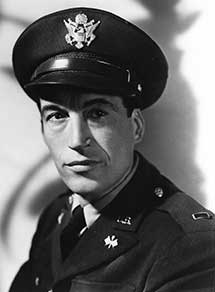




Harry Epstein - 1971 and M.A. in 1972
Tons of salient info in this piece. Thanks so much Frank !
Reply
Jack Gartner - BBA '47/MBA '48
What a fantastic article. I knew a little bit about Ford and Huston, but this was quite complete. Terrific.
Reply